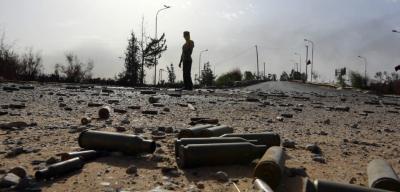Hezbollah, Houthi 'asymetric' tactics confound Israel, Saudis

ROME - The impact of various strategies of asymmetric warfare used in Middle Eastern conflicts was the central theme of three talks, hosted by the Euro-Gulf Information Centre (EGIC) by Professor Petrelli, Antonio Occhiuto and Matteo Bressan on Wednesday. Though the subject of asymmetric warfare isn’t rigorously studied by academic institutions, it is central to the majority of today’s conflicts.
Professor Petrelli spoke first, defining asymmetric warfare as a war between belligerents whose relative military power differs significantly, or whose strategies differ significantly. Asymmetric strategies are defined by The American Department of Defence as “attempts to circumvent or undermine an opponent’s strengths whilst exploiting his weaknesses using methods that differ slightly from the opponent’s usual mode of operations." They allow groups of armed forces like Hezbollah and Houthi to keep more powerful states in check.
He underlined that asymmetric warfare is not a new phenomenon, and expanded upon the evolution of asymmetric strategies over the years. Weaker belligerents have used asymmetric methods during conflicts against stronger enemies throughout recorded history. He cites the Lebanon War of 1982 as an example.
The Professor stressed that asymmetric strategies are cunning, and only employed by unstable combatants. They often destablise great powers by attacking their vulnerabilities and avoiding their strengths.
He emphasised that, though the intentions of all combatants around the world can be viewed from different perspectives, they all share the desire to obtain something. He finished his talk by emphasising that all combatants in the Middle East seemingly have political objectives.
Next to speak was Antonio Occhiuto, an analyst at the Euro-Gulf Information Centre. He focused more specifically on how Houthi rebels caused the military coalition led by Saudi Arabia and the United Arab Emirates to come unstuck in Yemen.
He first provided some background knowledge on Yemen, the poorest and most divided country in its region. A relatively new country, formed in 1990 when north and southern provinces unified, it has been experiencing regional and religious difficulties for decades. The country was united under Ali Abduallah Saleh, and the South never fully integrated.
The Houthis were marginalised and discriminated by the Sunnis. Houthi rebels posed a particular problem at the turn of the century, as instabilities in the country intensified. They resented their poor treatment and loss of state patronage, and became all the more radical when they realized that the years of negotiations and the 2011 revolution during the Arab Spring would not restructure power in Yemen.
They took advantage of the chaos caused by the Arab Spring in 2011 and conquered Sanaa and Yemen in 2014 and 2015. They are now fighting the Saudi-Emirati coalition.
He expanded upon their use of missiles, which they have used not only to kill, but also to instill fear into their opponents. They fired a series of missiles into Sanaa as a form of revenge for Saudi air strikes on Yemen.
He also addressed the United States’ role in the war, who have supported the Saudi-led coalition. They sold arms to the Saudis and used drone strikes. They also provided information from their Intelligence Services.
He concluded that Saleh’s death escalated the conflict without causing any significant change on the ground. He also analysed that the North-South divide is becoming increasingly polarised as the armed conflict continues, and stressed the tensions are only set to mount.
Matteo Bressan, an Analyst from the NATO Defence College Foundation, was the last to speak. He explained how the complicated situation in Libya represents the so-called “sword of Damocles” for Israel’s security.
He underlined that there is no common definition for terrorism; indeed, some people regard the Hezbollah Fighters as terrorists, while others regard them as “Freedom Fighters.” The only characteristic all terrorists share is their political aim, ideological or religious, and their use of violence, armed or cyber.
From Israel’s perspective, Libya’s strategic importance lies in its potentially destabilising impact on Egypt and its involvement in the regional struggle between Islamist and anti-Islamist factions. It has also become a conduit for Russia’s growing regional influence.
Israel also fears that a Libya-style popular uprising occurs in Syria and Jordan. It is symbolic of Israel's confusion that it is fearful of the fall of its enemy, Bashar al-Assad, the president of Syria and sponsor of Hamas and Hezbollah.
The talks held by the EGIC were organised in collaboration with the IPASS Roma 3 and in support of the Nato Defence College Foundation (NDCF).
jp-fh


